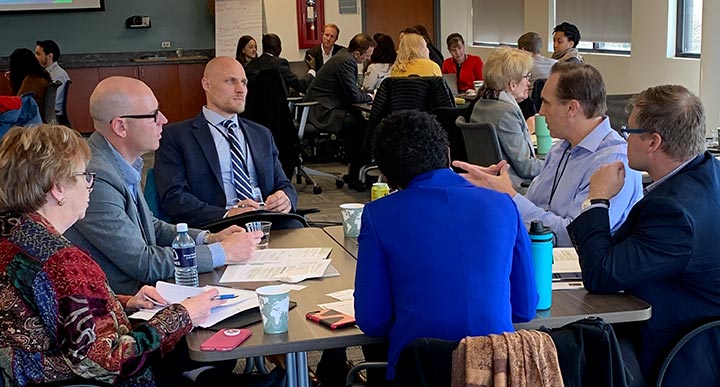Mining for a Solution: Integrating Renewable Energy into Mining Operations
November 21, 2019—On November 7, mining industry professionals from trade associations, equipment manufacturers, engineering firms, and other stakeholders along the minerals and metals supply chains convened in Golden, Colorado to discuss a proposed program to integrate renewable energy into mining operations.
The Renewable Opportunity in Mining workshop was organized by the Joint Institute for Energy Analysis (JISEA) and hosted at the National Renewable Energy Laboratory (NREL); along with partners, the Colorado School of Mines/Payne Institute and the Missouri University of Science and Technology.
JISEA Director Jill Engel-Cox and Greg Clough of the Colorado School of Mines' Payne Institute welcomed participants to the workshop hosted at the NREL campus.

Brainstorming solutions
The workshop aggregated industry feedback to define the scope of a potential collaborative program to boost the adoption of clean energy technologies in the mining sector. The program proposes a mix of technical analysis and capacity building among mining companies and related stakeholders to educate decision makers of the effective pathways to renewable incorporation.
NREL's Travis Lowder led a facilitated discussion around attendee priorities and perceptions for the program. Participants deliberated on current barriers to incorporating renewables, such as misalignment of energy sector and mining company commercial structures, mine site constraints, and the difficulties of incorporating variable renewables into operations with continuous, variable, and inflexible loads. They then brainstormed possible solutions to overcome such obstacles.
The renewables-mining nexus
Three keynote speakers set the stage on pivotal topics residing at the nexus of renewables and mining, followed by participant discussion sessions.
Joël Guilbauld of Hatch led a discussion on the technical barriers and potential solutions to integrating variable renewables into mining operations. According to Guilbauld, though 20-30% of renewable integration is feasible today, getting past the 50% mark is a steep technical challenge. In the breakout session that followed, workshop participants considered how to address current gaps in knowledge and capabilities for renewable integration into mining operations.
The second session of the day was led by Kristi Disney-Bruckner of the Sustainable Development Strategies Group, presenting on the role of renewables in social license to operate. She discussed the often difficult-to-define dimensions of social license to operate, and the growing importance of these considerations in mine planning.
Following her presentation, participants discussed issues such as the barriers and opportunities to transfer renewable energy projects to local communities after decommissioning the mine, and what the emerging concept of "stakeholder value" can mean in the context of renewables deployment.
Led by Kwame Awuah-Offei of the Missouri University of Science and Technology and Alexandra Newman of Colorado School of Mines, the third session covered the integration of renewable energy technology evaluation into the feasibility study process. The presenters suggested that in in this paradigm shift, design engineers need help understanding how these technologies can fit together. How mining companies operate using renewable power in place of diesel may result in different operational parameters. They posed the question: How does a company become the first to make this shift, knowing that there will be some inefficiency upfront?
In the breakout groups that followed, participants considered what type of analytical tools mine engineers and decision makers may need to better evaluate renewable energy technology integration into their analyses. They also drilled down into the capacity building needs for mining firms, regulators and government officials, and stakeholders to support renewable integration into mining.
Making a renewable powered mining future reality
Stemming from the discussions, participants identified areas of high priority to the mining sector and summarized them into a proposed program scope.
At the top of the list was engagement with the renewable energy industry and mining industry to develop model contract structures and business models to better align incentives and commercial structures between the two industries. Developing best practice analyses of commercial risk and technologies was pinpointed as a high priority area. Also flagged was the need to incorporate renewable energy power models into the mining industry models as well as provide simulation, analysis, and support for demonstration projects at participating mine sites.
For next steps, JISEA and its partners will revise the program concept to incorporate these priority areas. JISEA will then reach out to companies and organizations to collaborate these high priority topics. If you're interested in joining our consortium on clean energy and mining, please contact us.
Read recent JISEA mining supply chain analysis.
Back to JISEA News >
